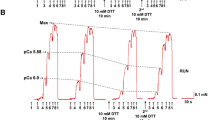Summary
Rats were trained by daily running exercises for 7 weeks. In addition, one group of rats was trained under the influence of propranolol, while another group received daily injections of propranolol only. None of the treatments used had influence on the activities of myocardial enzymes: 3-hydroxyacyl-CoA dehydrogenase (HADH), succinate dehydrogenase (SDH), malate dehydrogenase (MDH), and citrate synthase (CS) which were assayed for estimating oxidative capacity, or lactate dehydrogenase (LDH) which was used as a measure of anaerobic capacity. Training without propranolol resulted in elevated activities of the oxidative enzymes in M. extensor digitorum and in M. soleus. The corresponding changes in the rat group trained with propranolol always were much smaller, despite an equal amount of training. Only the trend for lowered activity of LDH was observable in skeletal muscle of the rat groups trained both with and without propranolol. Long-term beta-blockade alone did not induce enzymatic changes. It is concluded that a functioning sympathetic nervous system is necessary for the adaptive responses of muscular metabolism to training. Blockade of the sympathetic influence during exercise periods also hampers the training-induced responses.
Similar content being viewed by others
References
Baldwin KM, Cooke DA, Cheadle WG (1977) Time course adaptation in cardiac and skeletal muscle to different running programs. J Appl Physiol 42: 267–272
Bass A, Brdiczka D, Eyer P, Hofer S, Pette D (1969) Metabolic differentation of distinct muscle types at the level of enzymatic organization. Eur J Biochem 10: 198–206
Earl DCN, Korner A (1965) The isolation and properties of cardiac ribosomes and polysomes. Biochem J 94: 721–734
Ek L, åblad B (1971) Effects of three beta-adrenergic receptor blockers on myocardial oxygen consumption in the dog. Eur J Pharmacol 14: 19–28
Englard S, Siegel L (1969) Mitochondrial L-malate dehydrogenase of beef heart. In: Lowenstein JM (ed) Methods in enzymology, vol 8. Academic Press, New York London, pp 99–106
Harri MNE (1977) Metabolic effects of repeated short-term exposures to heat in the rat. Med Biol 55: 330–333
Harri MNE (1979) Physical training under the influence of beta-blockade in rats. II. Effects on vascular reactivity. Eur J Appl Physiol 42: 151–157
Harri MNE, Valtola J (1975) Comparison of the effects of physical exercise, cold acclimation, and repeated injections of isoprenaline on rat muscle enzymes. Acta Physiol Scand 95: 391–399
Harri MNE, Narvola I (1979) Physical training under the influence of beta-blockade in rats. I. Effect on adrenergic responses. Eur J Appl Physiol 41: 199–210
HirsimÄki Y, Vihko V, Ajiduah AO, Arstila A (1978): Postmortem changes in red and white skeletal muscle ultrastructure and in the activities of some enzymes of energy metabolism and lysosomes in trained and untrained mice. In: HÄnninen O, Harri M (eds) Proceedings: Symposium on Physical Performance and Muscle Metabolism, Kuopio, March 12–14, 1976. Somerpaino, Somero (Finn Soc Res Sport Phys Educ 57: 201–221)
Holloszy JO (1973) Biochemical adaptations to exercise. Aerobic metabolism. In: Wilmore JH (ed) Exercise and sport science reviews, vol 1. Academic Press, New York London, pp 45–71
Hoppleler H, Lüthi P, Claassen H, Weibel ER, Howald H (1973) The ultrastructure of the normal human skeletal muscle. A morphometric analysis on untrained men, women, and well-trained orienteers. Pfluegers Arch 314: 217–232
Issekutz B, Jr (1978) Role of beta-adrenergic receptors in mobilization of energy sources in exercising dogs. J Appl Physiol 44: 869–876
Kiessling K-H, Pilström L, Bylund A-C, Saltin B, Piehl K (1974) Enzyme activities and morphometry in skeletal muscle of middle-aged men after training. Scand J Clin Lab Invest 33: 63–69
Kral JG, åblad B, Björntorp P, Ek L, Johnsson G (1969) Metabolic and cardiovascular effects of adrenaline and alprenolol (Aptin) in human subjects. Pharmacol Clin 2: 40–45
Liesen H, Hollmann W (1972) Die Wirkung eines körperlichen Trainings unter Beta-Rezeptoren-Blockade auf Herzgrö\e, Blutvolumen und dem Arbeitsmuskelstoffwechsel. Verh Dtsch Ges Kreislaufforsch 38: 147–154
Lowry OH, Rosenbrough NR, Farr AL, Randall RJ (1951) Protein measurement with the Folin phenol reagent. J Biol Chem 193: 265–275
östman-Smith L (1979) Adaptive changes in the sympathetic nervous system and some effector organs of the rat following long-term exercise or cold acclimation and the role of cardiac sympathetic nerves in the genesis of compensatory cardiac hypertrophy. Acta Physiol Scand [Suppl] 477: 1–118
Parrat JR, Wadsworth M (1970) The effect of catecholamine infusions on myocardial blood flow, metabolic heat production, and on general haemodynamics, before and after alprenolol (H56/28), in anaesthetized cats. Br J Pharmacol 38: 554–571
Sigvardsson K, Svanfeldt E, Kilbom A (1977) Role of the adrenergic nervous system in development of training-induced bradycardia. Acta Physiol Scand 101: 481–488
Srere PA (1969) Citrate synthase. In: Lowenstein JM (ed) Methods in enzymology, vol 8. Academic Press, New York London, pp 3–9
Vihko V, Sarviharju P J, Havu M, HirsimÄki Y, Salminen A, Rahkila P, Arstila AU (1975) Selected skeletal muscle variables and aerobic power in trained and untrained men. J Sports Med Phys Fitness 15: 296–304
Vihko V, SoimajÄrvi J, Karvinen E, Rahkila P, Havu M (1978) Lipid metabolism during exercise. Il. Physiological and biochemical characterization of normal healthy male subjects in relation to their physical fitness. Eur J Appl Physiol 39: 209–218
Yakimenko M (1975) Muscle thermogenesis and cold adaptation. In: Janský L (ed) Depressed metabolism and cold thermogenesis. Charles University Prague, pp 115–118
Author information
Authors and Affiliations
Additional information
This research was supported by grants from the Ministry of Education, Finland (Nos. 8731/78/77 and 8224/78/78)
Rights and permissions
About this article
Cite this article
Harri, M.N.E. Physical training under the influence of beta-blockade in rats. Europ. J. Appl. Physiol. 45, 25–31 (1980). https://doi.org/10.1007/BF00421198
Accepted:
Issue Date:
DOI: https://doi.org/10.1007/BF00421198




